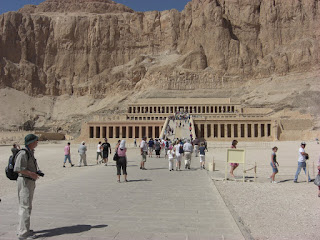
Our second day in Luxor was spent on the West Bank of the Nile. Our first stop was the Valley of the Kings (where you cannot bring a camera, so I have no photos to show). For 500 years, from the 15th to the 11th century BC, this was the primary burial grounds for the Pharaohs. The valley contains 63 known tombs and chambers, with the last one being discovered last year. It is most famous for the King Tut burial chamber, which was found mostly intact with all it's contents (now on display at the Egyptian Museum.

Our next stop was Deir el-Bahri, a temple dedicated primarily to Queen Hatshepsut. It was built by Senemut, who many now think was her lover (!). It is the closet Ancient Egyptians ever came to classical architecture.
From there we made our way to the Colossi of Memnon, which are two statues of Pharaoh Amenhotep III, which have been standing for 3400 years. Their original purpose was to stand as an entrance to Amenhotep's huge temple, but today, these are the only part of that left standing. Archaeologists estimate the original temple might have covered 35 acres before it was lost to time and the elements.
The statues stand about 60 feet tall and weigh about 700 tons each. The two statues were heavily damaged in an earthquake in 27BC, and one statue was reported to "sing" in the early mornings afterwards. It became a very popular site in the Roman world and people from all over the empire would travel here to see if they could hear singing. The name Memnon, or "ruler of dawn" was given to the statues as a result, for the legendary morning singing.



No comments:
Post a Comment